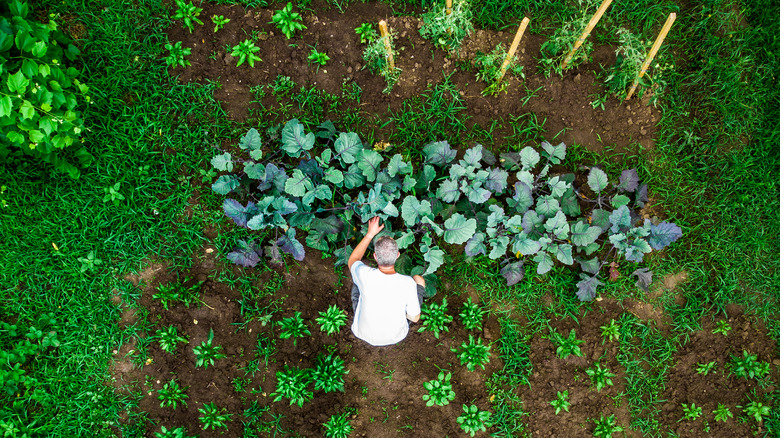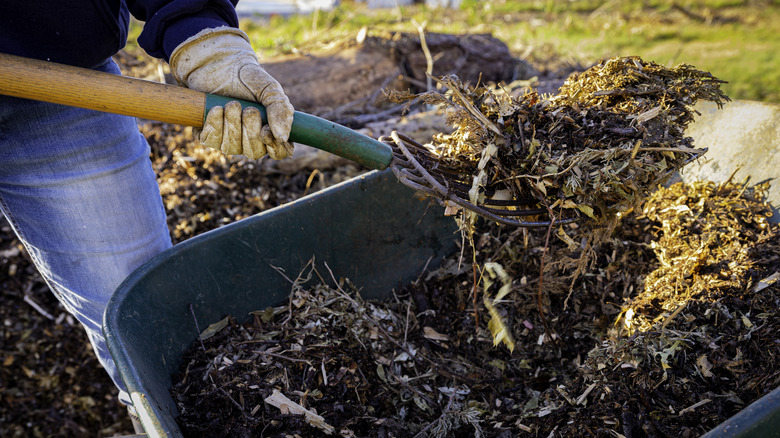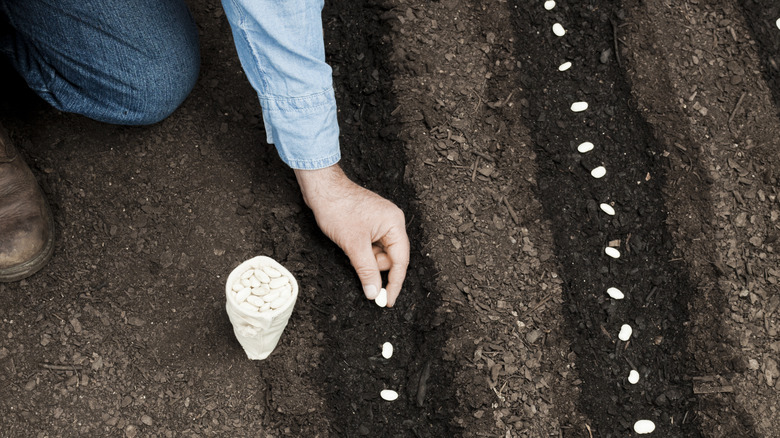Why Back To Eden Is The Perfect Method For A Thriving Garden
Back to Eden is a strong title for anything. Charged with imagery and biblical context, this method can sound more like a phony cult practice than a stroke of genius. In contrast to anybody's poor judgment, Back to Eden is the perfect method for a thriving garden. Pause momentarily and imagine a garden that doesn't need to be watered, tilled, or weeded. What does that look like?
Sure enough, you likely do not imagine a gardening philosophy that emphasizes mimicking natural processes to build fertile soil, conserve water, and promote the healthy growth of plants. Luckily, American farmer Paul Gautschi did, as he — struck by a compelling voice inside him — went into the woods to find out why it flourished while his crops were not. As if in a biblical story himself, Gautschi reflected on the simplistic, holistic, and nature-orientated ways of Eden. Now, gardening experts recognize the Back to Eden method as a perfect formula for a bountiful garden.
Notably, the Back to Eden method underscores the importance of organic mulch, such as wood chips, leaves, and compost. As the mulch decomposes, it nourishes the soil with essential nutrients, making it more fertile over time. By merely replenishing the mulch layer as it breaks down, this gardening method ensures that the soil fertility is continually rejuvenated, reducing the need for synthetic fertilizers. Moreover, the mulch fosters a friendly environment for beneficial organisms, improving soil health and structure.
Organic mulch is a king that serves
Back to Eden may seem complex, but honestly, it isn't. This method is one of least resistance, working with mother nature instead of fighting against it. Take a familiar challenge gardeners face, like maintaining soil moisture, especially during warmer months. Rather than worrying about overwatering and underwatering all the time, Back to Eden gardening manages this challenge beautifully and easily. The organic mulch mentioned above acts as an insulating layer, preventing the quick evaporation of water from the soil surface. It allows the soil to retain more moisture, reducing watering frequency. The method is, therefore, not only beneficial for the garden, but also water-efficient, work-efficient, and environmentally friendly.
This method also significantly boosts plant health. The nutrient-rich soil fosters strong plant growth, and the use of organic matter reduces the risk of soil-borne diseases. Plus, the mulch layer creates a barrier that makes it difficult for weeds to penetrate and establish, sparing gardeners from relentless weeding tasks. Additionally, as the garden's health improves, it becomes less attractive to pests, reducing reliance on chemical pesticides.
In a world increasingly focused on sustainability and eco-friendliness, any new transformative idea must significantly aid these causes. Back to Eden undoubtedly uses natural materials and processes to minimize dependence on external, often synthetic, inputs. It encourages recycling organic waste into compost, thereby reducing waste. Furthermore, its water conservation properties suit areas with water restrictions or scarcity.
How to create your very own Back to Eden garden
Let's explore how you can create your own Back To Eden garden. Although it doesn't require many tools, it's worth mentioning that you'll need the following basics to achieve all of this. Have a spade or shovel handy, a wheelbarrow or garden cart for transporting compost, and a garden rake for spreading. But no more time wasting; let's get down and dirty.
First, choose a location in your yard that receives plenty of sunlight — ideally, around six to eight hours daily. Next, and most importantly, you'll want to prepare the ground by covering the selected area with about three or four sheets of newspaper or paper; this will help stop the growing weeds. On top of this, add 3-4 inches of organic compost or composted manure, which acts as a nutrient-rich food for your plants. Paul Gautschi recommends using a mulch scoop shovel to transfer compost.
The fourth step is to add 3-4 inches of mulch, like wood chips or leaves, on top of the compost. This mulch layer helps keep the soil cool and retains moisture, meaning you'll have to water your plants less. Did you know that you can sign up for a free wood chip delivery on ChipDrop, depending on your location? Try it out as well as a mulch calculator if unsure of how much you need — just measure your garden, select the options you're looking for, and it will calculate it all for you.
It's time to plant your seeds
Now that most of the dirty work is done, you're ready to plant your seeds. Before you begin, Paul Gautschi recommends ordering from a certified organic, non-hybrid, non-GMO heirloom seed supplier, like SeedsNow. This is popular amongst many Back to Eden gardeners. Once you have acquired those, you will want to grab your rake and make a straight line. Start this step by tying one end of a rope to a stake and the other to a second stake at the opposite side of the garden. Then draw your straight line.
But, before you go tossing heirloom seeds all over your wood chips, be sure to move the mulch to the side, dig a hole, and place your seeds in the soil. It's essential to follow this step correctly, as the mulch is only a covering, not a soil. Finally, to maintain your garden, add more mulch as it breaks down over time to keep the soil healthy and productive. Remember, a Back to Eden garden mimics how plants grow in nature. While it may require some initial effort to establish, it leads to a low-maintenance garden full of healthy, thriving plants.
Helpful tips for success from farmers and gardeners
No matter how easy something may seem, there is always the possibility of it going wrong. To be successful at anything, you will need patience, especially if you're jumping into this hobby right away. But don't fear. Thankfully, this has become a worldwide practice, and you can find plenty of answers online from those who have experience doing this. Here are three helpful tips to consider when starting this revolutionary journey.
Tip number one: Start small! It's never helpful to overwhelm yourself when starting something new. Learn and observe as you go, then expand over time. Tip number two: Timing matters. You'll want to make sure you finish the beds in no more than two to three days. The reason is that the newspaper could fly away, compost can dry out, and all of this combined can leave you frustrated and disinterested. Tip number three: Diversify your planting. A diverse garden is generally more resilient. Planting a mix of vegetables, herbs, and flowers can improve your garden's health and attract beneficial insects and other pests.
The Back to Eden gardening method is a journey, rather than a destination. By sticking to what you know and seeking knowledge, you will continuously refine your approach and create a prosperous, resilient garden that requires less work over time.
Back to Eden without the forbidden fruit
The Back to Eden method is accessible to all — from beginners to seasoned gardeners, making it unique. But, like the story of Adam and Eve, not everything is perfect. This method has some downsides, and unless you're an experienced farmer or gardener, some of these problems may be difficult to solve on your own and spoil your fun (that's why you should always remember tip number one!). The most common problem is with wood chips and nitrogen, or lack thereof. For those who may not know, nitrogen is essential in supporting plant growth. If you begin to see leaves wilting or turning yellow, you might want to add composted chicken manure to help fertilize it.
Singlehandedly, the Back to Eden method offers a paradigm shift in gardening techniques, taking us back to nature's inherent wisdom for growing plants. Paul Gautschi's passionate dedication to sustainable agriculture and his insights give a fresh perspective on gardening and farming. Whether you decide to join in on this gardening journey or ride its enlightening wave, there's no doubt that you'll garner valuable insights about nature's profound ability to sustain itself.




